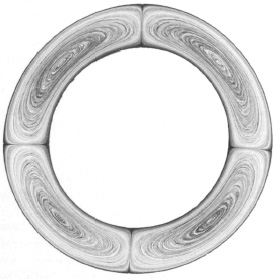5.5.1 Non-uniform mixtures
Moulded rubbers and plastics are compounds of a polymer matrix and a variety of additives. The mixing history of the material before and during the moulding process can have a critical influence upon the final product properties. If mixing is done badly then the microstructure of the moulding can be non-uniform. Lack of uniformity can cause variations of strength and other physical properties within the moulding. The degree of dispersion or distribution of relatively minor quantities of additives can have a significant effect upon the properties of the product. This is illustrated in Figure 52 which shows a thin slice of polyethylene tubing of diameter 5 cm. PE masterbatch, heavily pigmented with carbon black, has been added to the unpigmented granules in the hopper of the extruder, in order to improve UV resistance. The poor state of mixing gives a laminated section to the tube, very like a rolled-up newspaper. The outside surface appears black and so gives some measure of protection against sunlight, but the maldistribution of carbon black weakens the material by concentrating stress locally at clusters of particles. Although the apparent degree of orientation is high, the polymer molecules in reality have a relatively low degree of orientation.

Many plastics composites use fibres as the reinforcing agents within a polymer matrix. The distribution of orientations of the fibres then determines the overall anisotropy of the components. Suppose for example that a laminate is made from sheets of resin-impregnated glass fibre cloth, plied together so that the warp and weft directions of successive layers coincide.
The properties in the orthogonal warp and weft directions are different from each other and are different again from the properties through the thickness of the laminates. Similar symmetry applies to the biaxially oriented stretched films which are used as outer wrappings for many consumer goods and supermarket foodstuffs, as well as PET bottles, although in these examples the orientation is molecular in origin.
